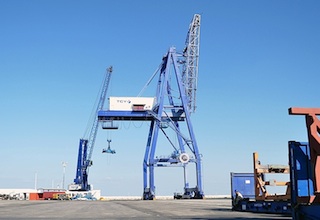DC drives from Control Techniques, an Emerson Industrial Automation company, were selected by Terminal de Contenedores de Yucatán (TCY) to modernize the control system on an aging ship-to-shore crane in Progreso, México.
TCY, owned by Grup TCB of Spain, is a large container and cargo-handling terminal in Mexico’s Yucatan peninsula. David Asensio, Project Manager for Grup TCB, commented that “The cranes are in good mechanical condition, but poor electrical condition.” Replacement parts for the old DC drives had become nearly impossible to find and could take weeks to obtain, leading to unacceptable downtime.
For this application, Control Techniques proposed an all-new, fully integrated drive and control system featuring its Mentor MP DC drive. The new control system encompasses all the electrical equipment including low-voltage auxiliaries, DC drives, PLC, I/O, crane management system and MCC. Also included are new remote I/O and control stations, RF Ethernet-based remote diagnostics, and a modern rotating operator’s chair and consoles to replace the old sliding chair and fixed consoles. It provides TCY with a higher degree of reliability to increase uptime, a rapid supply of spares and remote monitoring and diagnostics to facilitate troubleshooting and maintenance.
Hoisting, trolley, boom and gantry movements are all driven by DC motors that are controlled by means of Mentor MP digital drives connected via a Profibus network to a controlling PLC. 
The Mentor MP is a reliable, flexible and powerful digital DC drive that maximizes motor performance, enhances system reliability and interfaces digitally with the latest control equipment using Ethernet and a wide range of industrial networks. The drives feature a series of user-configurable functions (master-follower management, electric shaft function, digital or analog feedback, and torque control, among others) that are arranged logically in different menus and preconfigured with default values to facilitate commissioning.
Operational parameters can be selected and modified from the drive keypad or through the Windows-based software, CTsoft. The SM-Application solution module is an easy plug-in second processor, capable of writing application-specific programs without using a PLC or standalone controllers. It’s programmed using SyPT, an IEC 1131-compliant programming tool incorporating function block programming.
The SM-Application modules of the two drives that operate the hoisting motors and connect via Control Techniques’ own high-speed network, CT-net, use a load balancing function to control container hoisting and calculate the maximum lifting speed as a function of the load hooked to the spreader.
Using a series of customized basic, modular and open-ended software packages, developed by Control Techniques specifically for crane control maximizes crane productivity. These are programmed into the PLC and onboard SM-Application modules, and connected via fieldbus.
Control Techniques also designed the Crane Management System integrated into its basic software and enhanced with control modules for the maintenance guide and diagnostics. Operational at the various levels of automation, these software packages automatically signal events as they occur, guiding the operator in maneuvers and assisting technicians with repair and preventive maintenance operations.


Leave a Reply
You must be logged in to post a comment.